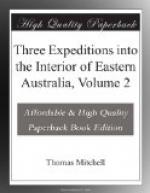September 20.
Our wheels now rolled lightly over fine grassy downs and our faces were turned towards distant home. Before us arose a low, thinly-wooded hill, which at first bounded our view towards the north, and afterwards proved to be the feature connecting the low woody ridge near our last camp with the hills still further to the northward. On reaching the summit I perceived that a considerable extent of open country intervened, being watered in the lower parts by several lakes.
MOUNT NICHOLSON. COCKAJEMMY SALT LAKES.
Descending northward along an offset of the same hills which had led us in that direction and which I now named Mount Nicholson, I observed that the lakes occurred at intervals in a valley apparently falling from the westward in which no stream appeared, although it was shut in by well escarped rocky banks. We encamped after a journey of ten miles at a point where another valley from the north joined the above, and I was somewhat surprised to find after encamping that the water in the adjacent lakes was extremely salt. No connection existed by means of any channel between them although they formed together a chain of lagoons in the bed of a deep and well defined valley. On the contrary the soil was particularly solid and firm between them, and the margin of the most eastern of these lakes was separated by a high bank from the bed of another valley where a running stream of pure water flowed over a broad and swampy bed fifteen feet higher than the adjacent valley containing the stagnant salt lakes. The rock enclosing these singular valleys was basalt, and from these peculiarities, considered with reference to the ancient volcano and the dip of a mountain strata to the north-west, it was evident that some upheaving or subsidence had materially altered the levels of the original surface.
I could find no brine-springs in or about these lakes, and as it was evident that a stream had once washed the bed of the ravine now occupied by them, I may leave the solution of the problem to geologists.
(Footnote. Having submitted specimens of the water from these and other salt lakes of the interior to my friend Professor Faraday, I have been favoured with the following particulars respecting their contents: “All of them are solutions of common salt much surpassing the ocean or even the Mediterranean in the quantity of salt dissolved. Besides the common salt there are present (in comparatively small quantity) portions of sulphates and muriates of lime and magnesia: the waters are neutral and except in strength very much resemble those of the ocean. That labelled Greenhill Lake 24th July had a specific gravity of 1049.4 and three measured ounces gave on evaporation 97 grains of dry salts. That labelled Mitre Lake 24th July had a specific gravity of 1038.6, and three measured ounces of it yielded 77 grains of dry saline matter. The water labelled Cockajemmy Lake Camp 20th September had a specific gravity of 1055.3 and the amount of dry salts from three measured ounces was 113 grains.”)




